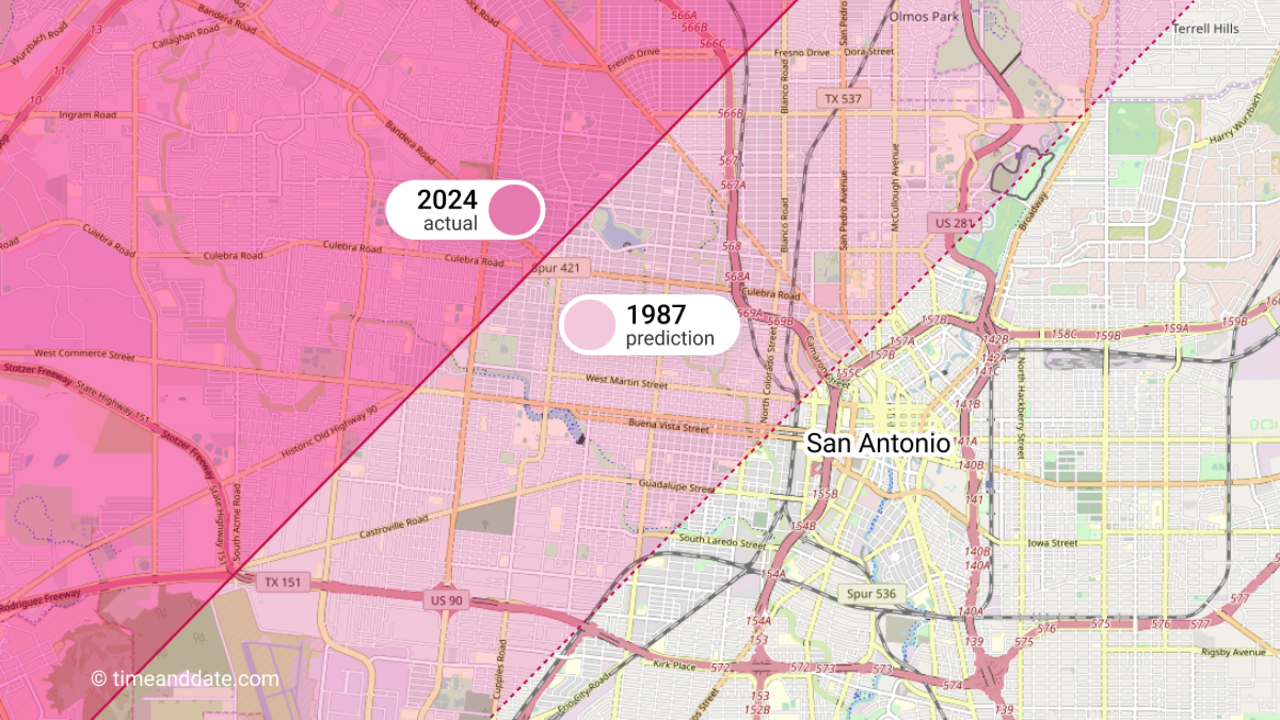How San Antonio Lost the 2024 Great American Eclipse
A few decades ago, parts of downtown San Antonio were predicted to have half a minute of totality on April 8. But as a result of Earth’s unpredictable rotation, the city center will miss out.

Downtown San Antonio is a few miles outside the path of totality for the total solar eclipse of April 8, 2024. But things nearly turned out differently for the second-biggest city in Texas.
©San Pedro Creek Culture Park
Earth’s Spin Affects Eclipse Predictions
Solar eclipses can be predicted with remarkable accuracy—with one main uncertainty.
Every day, the speed of Earth’s rotation varies by a fraction of a millisecond. Over a number of years, these tiny variations can add up to a few seconds.
This makes a difference to eclipse predictions. If the Earth spins more quickly than expected, the Moon’s shadow will strike a bit farther west than we thought.
Astronomers and mathematicians, including our programmers here at timeanddate, account for changes in Earth’s rotational speed by including a number known as ΔT (pronounced “delta T”).
The problem is that we don’t know exactly how Earth’s spin will change in the future. In other words, the value of ΔT that we use for predicting eclipse paths is only an estimate.
All eclipses worldwide, 1900 to 2199
Today’s ΔT Value Is Less than Expected
In recent years, Earth’s rotation unexpectedly speeded up. In December 2020, we reported the surprising news that 2020 had included the 28 shortest days since the development of the atomic clock.
The increase in Earth’s speed meant that estimates for future values of ΔT became too large.
One of the most distinguished sets of eclipse predictions is NASA’s Fifty Year Canon of Solar Eclipses, published in 1987. The author was Fred Espenak, a celebrated astrophysicist known as “Mr. Eclipse.”
For his calculation of the April 2024 total solar eclipse, Dr. Espenak used an estimated ΔT value of 85.7 seconds. Fast forward 37 years, however, and the actual value of ΔT in 2024 is 69.2 seconds.
Total solar eclipse: April 8, 2024
Predicted Eclipse Path Shifts by a Few Miles
The difference between the 1987 estimation and the 2024 actual value of ΔT is +16.5 seconds. This means that, at the latitude of San Antonio in Texas, the eclipse path will be around 6.7 km, or 4.2 miles, farther to the west than predicted in 1987.
For San Antonio, this has significant consequences. According to the 1987 prediction, the edge of the path of totality—where the Moon completely covers the Sun—would have cut through the western part of downtown San Antonio.
For example, the Cattleman Square Historic District would have enjoyed around 30 seconds of totality.
But instead, thanks to the unforeseen speed of Earth’s rotation, the path of totality will miss the city center altogether. Cattleman Square will have a 99.98% partial eclipse: close, but no totality.


The dark band running through this map shows the path of totality across Texas on April 8, 2024. (The dashed line marks the center of the path.) Cities such as Dallas, Austin, Llano, and Kerrville are inside the path of totality—a total eclipse will be visible at these locations. But the center of San Antonio is just outside the path.
©timeanddate.com


Zooming in on San Antonio, the two diagonal red lines show two positions for the edge of the path of totality: the position predicted in 1987, and the actual position on April 8, 2024. According to the 1987 prediction, totality would have been visible in western parts of downtown. In fact, the path of totality will miss the city center altogether.
©timeanddate.com
Why Is Earth’s Rotation So Unpredictable?
The day-to-day changes in Earth’s rotational speed are the result of the complex motion of its liquid core, oceans, and atmosphere, plus other effects.
Some factors are well understood. For instance, variations in the Moon’s distance from Earth are responsible for a monthly pattern of peaks and troughs in the rate of Earth’s spin. Long-term patterns, on the other hand, are poorly understood.
“We’ve tried internally modeling things for the next two or more years,” Nick Stamatakos, at the United States Naval Observatory, told timeanddate in 2021. “But we run into trouble predicting more than six months or one year ahead.”
The Texas cities that lost an annular eclipse in 2023
There are other factors, too, that can affect the accuracy of eclipse predictions, particularly near the edges of eclipse paths. These include altitude (eclipse calculations are normally based on sea level), uncertainties in the size of the Sun (with a margin of error of around 0.03%), and the roughness of the Moon’s surface (deep valleys along the Moon’s edge affect the size of the Moon’s shadow).
Follow the Path of the Moon’s Shadow
You can check the path of totality across North America on April 8 using timeanddate’s interactive map.
“Our team has worked a lot on new map features in preparation for this eclipse,” says Brendan Goodenough, a member of our astronomy team. Brendan is responsible for the frontend (user interface) part of our eclipse pages.
“My favorite new feature is our shadow path animation,” he adds, “which allows you to see both exactly when and where the Moon’s shadow will be.”